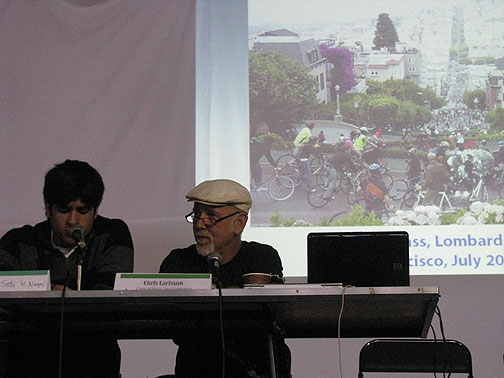
Listening to my introduction from "Negro", Sept. 18, 2009.
Thanks for inviting me! I apologize in advance for my poor Spanish. I’ve never tried to speak publicly in Spanish, so I beg your indulgence.
I’m very happy to be in Guadalajara, which my father-in-law explained to me was once dishonored by the label “Pueblo Bicicletero,” but today that same label indicates a city far advanced rather than behind. Bicycling is enjoying a new Renaissance in most of the world. My friend Ted White did a short documentary on the resurgence of cycling and called it “The Return of the Scorcher,” a name given bicycles in the late 19th century because they went so fast that they burned up the roads, hence “scorching.”
As we gather to discuss urban cycling, it’s useful to recall that there were mass bike rides of thousands in many cities, including San Francisco where I live, in the 1890s. In those days, cyclists belonged to various clubs and associations and when they rode 8,000-strong in July 1896 (before the invention of the private automobile) they had a demand: asphalt and Good Roads! Sometimes you get what you ask for but it doesn’t quite work out the way you plan!
Even darker in the early history of bicycling is the role of that new invention, the air-filled rubber tube or tire. Today rubber is made from oil but in the late 19th century it was only available from rubber trees tapped in the Amazon and the Congo. King Leopold II of Belgium took personal control of the Congo during that imperialist era and used his army to brutally exploit the Congolese. They were ordered to bring in hundreds of kilos of wild rubber every few weeks or have their families tortured and murdered, or even have their own limbs cut off as punishment. Over a million people died during this forgotten holocaust, while millions more were mutilated. What drove this madness? The rising demand in Europe and the United States for rubber. And what drove the demand for rubber in the 1880s and 1890s? The bicycle! So we cannot forget that the bicycle, too, is an industrial device, and has its own dark history like most aspects of the modern world.
In our car-choked modern cities, we cyclists are again the fastest vehicle on the road. Personally, I’ve been riding my bike nearly every day for over 30 years. Living in San Francisco, with its famous hills and cooling fog, I became expert at using the landscape to my advantage. One of the hidden pleasures of urban cycling is how it reveals the forgotten secrets beneath the cement. When you’re rolling downhill, you’re approaching the historic waterways that predate urbanization. When you’re pedaling uphill you are leaving those forgotten creeks and streams behind. In San Francisco, the intrepid cyclist of the 1980s, trailblazers for the many thousands who started cycling in the decades since, pioneered many of the routes that are now commonly used to avoid steep hills. One famous way is called The Wiggle because of how we zig-zag along an old waterway, avoiding steep climbing to go from one neighborhood to a much higher one.
During those long-ago years, cycling was mostly a solitary experience. One could ride for many blocks and only see one or two other cyclists. Today, it is common to find 10-20 cyclists bunched up at each red light on Market Street, the city’s major thoroughfare. Some neighborhoods have so many people on bicycles now that we are starting to worry about bicycle-bicycle collisions at busy intersections.
How did San Francisco become such a capital of bicycling? Given its big hills and windy weather, it’s not an obvious location for intense urban cycling at first thought. But some dozens of us slowly advanced the cause, mostly by asserting our right to the road by daily cycling. In the late 1980s, cycle couriers, or bike messengers, became a thriving subculture of the city’s working class. Styling themselves as rebels and outlaws” and clearly rejecting “normal” work lives for the relative freedom of the city’s streets” the messengers were a visible population of daily cyclists that offered an alternative to the spandex-clad, expensive equipment-laden racers and tour riders who made bicycling seem like it was only for nerds or wealthy consumers of bicycle chic.
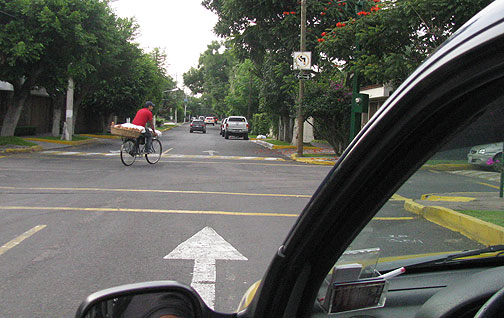
This bread delivery guy (bici panadero) was just ahead of us as we taxiied in to the Congress.
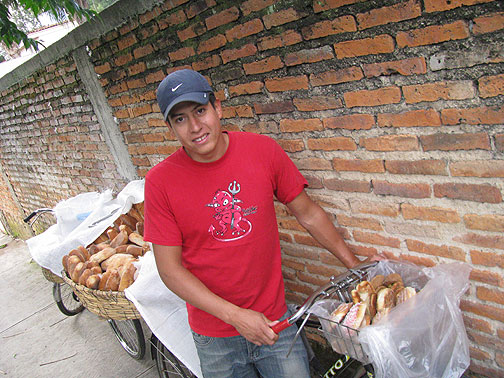
The bici panadero up close.
I want to interrupt my speech because my wife, Adriana Camarena, has reminded me frequently that Mexico has a magnificent tradition of workers on two or three wheels. For more than a century, cyclists have transported bottles of water, flowers, bread, newspapers, mail, telegrams, prescriptions, and food. Even the knife sharpener works on his bicycle! Not everything has been lost to the invasion of the automobile.
Meanwhile, ecologists and urban activists were turning to the bicycle for several reasons. It was a demonstrably more ecological transit choice. It saved money otherwise wasted on cars, gas, parking, insurance, or public transit. But the most important reason, hard to perceive until giving the bicycle a try, is that it felt very very good! Exercising the body was important, but the surprising benefits of bicycling are social as much as physical. Instead of being trapped in a metal box with corporate propaganda pouring out of the radio, the cyclist is free to move in and out of traffic, hearing the whole city, finding friends, learning about the truth of daily life from direct experience instead of edited sound bites. When you see a friend on the street, instead of frantically trying to find a place to stop your car, or waving from a bus or tram window, on a bike you can just pull over immediately.
So cyclists started to find each other. From conversations and encounters many people expressed a rising interest in using bikes to do politics. In the late 1980s, the San Francisco messengers rode in a great circle around City Hall to protest efforts to regulate their anarchic culture. In 1990, Bay Area Bike Action staged an Earth Day ride through Golden Gate Park, demanding parks over parking lots. Before January 1991, when the first George Bush attacked Iraq over the invasion of Kuwait, huge anti-war marches filled San Francisco’s streets on many occasions. When the bombing started a few dozen cyclists rode over 100 kilometers up the coast to protest, while dozens of cyclists appeared with the street protests, functioning as scouts for the protesters on foot. Bikes and politics were in the air!
Lost in the mists of countless beer-lubricated conversations among dozens of cyclists from 1990 to 1992, the idea started to take shape: let’s fill the street with bicycles and by so doing, displace car traffic. During this same period the San Francisco Bicycle Coalition was slowly rising from the ashes of its previous demise in the early 1980s. In mid-1992, about 10-20 earnest cyclists were meeting as the SFBC once a month in the back of a Chinese restaurant. At this time they had no office, no paid members or staff. (By contrast, today, some 17 years later, the Bike Coalition has a dozen paid staffers, over 10,000 dues-paying members, and a top floor office in the city center, with a budget around a half million dollars a year!)
In August 1992, I proposed to a Bike Coalition meeting that we should start a “ride home together” on the last Friday of the September. They cautiously embraced the idea, but the next day called me to make sure they weren’t officially sponsoring the new ride. That was fine since the dozen of us behind the proposal didn’t want official sponsorship either. This was going to be an “organized coincidence!”
Amazing to think it’s been 17 years since the first “Commute Clot” brought together 48 or 52 bicyclists at “PeeWee” Herman Plaza at the foot of Market Street in San Francisco. Within a few short months it had gained the moniker “Critical Mass” and the excitement and euphoria and sheer novelty of streets filled with bicycles instead of cars was rapidly reproducing itself across the planet.
Now there are websites galore documenting Critical Masses in towns everywhere, from Australia to Italy, Chile to Canada. Of the more than 400 places where Critical Mass rides have taken place, hundreds continue to ride every month. At the end of May for the past few years, an “Interplanetary Critical Mass” has been held in Rome, Italy, drawing several thousand riders from around Italy and the world. In April and September Budapest, Hungary has its twice-annual Critical Mass rides, reaching 50,000 riders in September 2008! Hundreds of rides occupy the streets of US cities on the last Friday of each month, from big cities like Chicago and Los Angeles, to the smaller burgs in the hinterlands like Cincinnati, Ohio, Grand Rapids, Michigan, and Raleigh, North Carolina. And of course thousands of us are still riding after all these years at the birthplace in San Francisco, where every month we get between 1,500 and 3,000 cyclists without any ongoing publicity or organizing efforts.
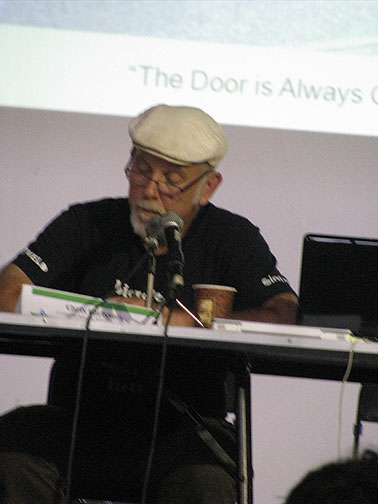
Yeah, I had to read it, but at least I did it in Spanish!
People who embrace cycling and come out to ride in Critical Mass come from all walks of life, widely varying incomes and housing situations, and cannot be characterized accurately as part of a “class” as it is commonly understood. Also, the folks stuck in traffic in cars or on busses are clearly more like than unlike the riders who are temporarily altering the rhythm of urban life by seizing the streets on bicycle. Nevertheless, Critical Mass cyclists are the most visible practitioners of a new kind of social conflict. The “assertive desertion” embodied in bicycling erodes the system of social exploitation organized through private car ownership and the oil industry. And by cycling in urban centers in the heart of the Empire, we join a growing movement around the world that is repudiating the social and economic models controlled by multinational capital and imposed on us without any form of democratic consent.
This mass seizure of the streets by a swarming mob of bicyclists without leaders is precisely the kind of self-directing, networking logic that is transforming our economic lives and threatening the structure of government, business, and (as more imaginative military strategists are coming to understand) policing and war-making too. So the local police and authorities often respond with great frustration and confusion to the eruption of a tactical flexibility for which they’re simply unprepared. And in classic patriarchal fashion, they lash out with physical punishment as best they can, trying to repress what they cannot understand or control. But like the insurgency in Iraq, or any guerrilla war, when a blundering monster attacks in classic old-style ways, the new, mobile, decentralized networks just vanish, leaving the attackers swinging at air (perhaps they “catch” a few individuals now and then). The structure that is threatening the status quo remains intact” and often grows stronger” just like Critical Mass has in most places it has been attacked.
Police Repression Near and Far
In July 1997, police attacked Critical Mass in San Francisco. It was a boring summer without much news, and the Mayor at the time decided to pick a fight with Critical Mass bicyclists. He announced in June that the ride would have to become more organized by his standards. His assistants called various local cyclists, including me, and some chose to attend a meeting (I refused to go. I knew his style, which was to lure people into a backroom negotiation and then turn the results against you.). Some members of the local San Francisco Bicycle Coalition Board of Directors attended the meeting and were shocked the next day when it was announced (falsely) that they had made agreements with the City. Not only was it impossible for them to represent Critical Mass, they hadn’t agreed to anything in the meeting!
When the day arrived a lot of us were angry and ready for anything. To our great insult, the big daily newspaper had published the “official route” of Critical Mass that morning, as decided by the police! By contrast, we published a flyer calling for cyclists to go everywhere! We arrived at the starting point and the police had installed a sound stage. Various officials were welcoming us to our own event, including the very unpopular Mayor Brown. We jeered him, which surprised and angered him. A short time later the ride began amidst hoots and catcalls at the Mayor and police. Thousands of cyclists started out while behind us, the Mayor put the word out to his police to stop the ride. Instead, an evening of wild chaos ensued, as some 5000 or 7000 cyclists broke up into smaller groups of 300-1000 and rode in different directions. The police could only chase around impotently, but for the most part cyclists and motorists coexisted that night, like most Critical Mass rides. At one point a small squad of motorcycle police blocked the main street (Market Street) and began arresting a few cyclists for “failure to disperse.” One bulky officer was photographed straddling a small female bicyclist, his knee on her neck. (Later this same officer claimed he was assaulted by the woman, and when she brought the photo to court, the charges were dismissed, and she filed charges against the policeman.) At the end of the night, about 100 cyclists were surrounded and arrested for the simple reason that they were easy to catch, bringing the total arrests to about 112 for the night.
The next morning the newspaper headlines screamed 250 arrests, a bicyclist riot in San Francisco! This was completely false, but it was difficult to answer in the days that followed. Most of us decided the best strategy was to lay low and let it blow over, which is what happened. One man who was arrested sued the city for false arrest and won his case, getting a cash award for his trouble from the City. No one was convicted of any crimes from events of that night. One month later another huge crowd of cyclists turned out and this time we followed the technique of “Good Soldier Schweik,” an idea from a Czech author after WWI, who described “working to rule” where you follow every rule exactly. As thousands of cyclists entered the road, behaving completely legally, riding in single file in each lane, stopping at every light and stop sign, traffic ground to a halt in San Francisco. We proved that we could fill the streets with bikes and if we followed their rules, it was MUCH worse for the city and other motorists. After that, the police have never bothered us much again. Occasionally they decide to write a few punitive tickets, but mostly they ride along, getting their overtime pay, happy to look at all the nice-looking women and men in the ride while getting paid double.
In other cities, the police have been more successful at stopping Critical Mass, partly because the riders themselves haven’t been as creative with the ride and its logic. In Austin, Texas and Minneapolis, Minnesota, police departments have attacked and arrested Critical Mass cyclists and successfully discouraged a lot of people from participating in those cities. In Portland, Oregon, a very bicycle-friendly city, Critical Mass died out when the culture was too dominated by angry young men (in San Francisco we call them the Testosterone Brigade) who think there is a “class war” between cars and bikes. They go out of their way to block cars, to taunt and provoke motorists, especially those in expensive cars. Those doing it are proud and feel like they’re pushing things to the limit, but to the rest of us they look cowardly, hiding behind the mob to act out unresolved parental psychological dramas!
Obviously inanimate objects don’t have class wars, and to target people in cars as the enemy is a huge political mistake. Car drivers are not the enemy, but our natural allies! The point of Critical Mass has always been to create an inviting, celebratory space that is so contagious that people who might not bicycle much are irresistibly drawn to trying it out. If you call people names, try to make them feel guilty or ashamed, there’s little chance they will change how they think and further, change their behavior. Our pleasure is more subversive than our anger, and it’s a difficult lesson for some people to remember in the heat of the streets.
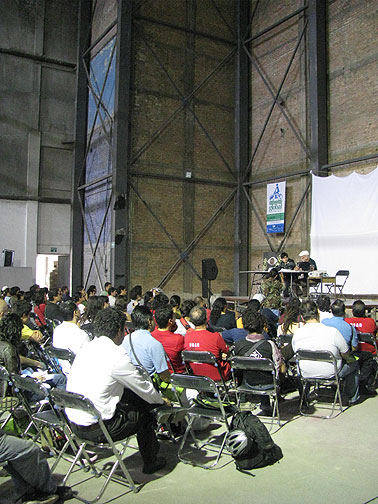
A sense of the space, LARVA, where we were meeting.
One of the best examples I know of comes from a woman I met in Rome, Italy. She works for the World Health Organization and in 2005 or so, she found herself stuck in traffic on her way home, temporarily delayed by Critical Mass. The sight of hundreds of happy cyclists riding through the streets was immediately appealing to her, and she resolved to join the next month, which she did. It changed her life, as she became a daily cyclist, realizing through Critical Mass how much easier it was to ride in Rome than she’d imagined. Moreover, she convinced 1/3 of her fellow workers to also switch to cycling, so her office became a great example of the relatively invisible “results” of Critical Mass in changing behavior.
In New York in 2004 during the Republican National Convention, a huge Critical Mass was attacked by New York police, who spent the following three years trying to stop Critical Mass, criminalize cycling, seize and impound thousands of bicycles, and use the whole campaign to write new rules for assembly and speech, violating U.S. constitutional protections. Thankfully they were defeated in large part by a combination of activists, cyclists, and progressive lawyers who defended civil rights over those years.
It’s easy to forget that one of the best things about Critical Mass is that it puts hundreds and thousands of us in the streets together where the rules and etiquette aren’t always clear. That means we have to solve problems as they arise by talking to each other, working things out in the pressure of the moment, and getting important practice in political self-organizing and self-management. In the United States during the past two decades a serious Culture War defined the society, with right-wing Christian fundamentalists increasingly emboldened to try to control the behavior of the rest of the society. On the other side are millions of people who believe in high levels of personal freedom and tolerance, and you can find a lot of the most ardent and articulate of those folks riding their bikes in Critical Mass. The police, unfortunately, are often very influenced by the right-wing side of the Culture War and individually many officers have decided they should raise the price of participation in the ride by writing tickets, arresting cyclists, and occasionally attacking them. (Not too long ago a 3rd generation police officer, only 23 years old, was standing in a New York street as Critical Mass cyclists were streaming by on either side of him. He suddenly body checked a rider to the ground, and thanks to a tourist video, this became a big hit on Youtube. He was surprisingly suspended from street duty, but his behavior is indicative of police attitudes in New York and elsewhere.)
A Public Life in Common
The most important thing about Critical Mass, and by extension bicycling, is not the device or its use, but how it changes the texture of urban life. When hundreds and thousands of cyclists seize the streets for a convivial and celebratory use of public space, most of the expectations and rules of modern capitalism are challenged. Individual behaviors escape the logic of buying and selling, if only for a few hours. You don’t have to buy anything to participate in Critical Mass, neither an object or service, nor an ideology beyond a desire to partake in public life on two wheels. Once in the street together, unexpected connections emerge, unplanned events occur, and serendipitous relationships begin. Unlike a trip to the mall or the market, the conversations are unburdened by the logic of transactions, of prices and measurements. It’s a free exchange among free people.
The experience alters one’s sense of city life immediately, and more importantly, shifts our collective imaginations in ways we have only begun to learn about. Many riders I’ve met over the years have become employed in urban planning, landscape design, transportation planning, etc. Many of them, inspired by their Critical Mass and bicycling experiences, are determined to reshape streets and plazas to bring back a public life lost to the domination of the market. In most cities in North America efforts are underway to reconnect city dwellers to the nature beneath the pavement, whether by rejuvenating local waterways, opening pedestrian zones where cars have been dominant, or holding festivals that reclaim streets for public celebration.
Bicycling and urban planning activists dream of redesigning streets to change current patterns, and to be sure, this is an important contribution. In Copenhagen Denmark they began putting in sidepaths between sidewalks and streets in the mid-1960s and today, nearly a half-century later, almost 40% of all daily trips in Copenhagen, whether you’re 8 or 88 years old, is by bicycle! Bogota, Colombia has built an extensive network of cycle paths and it’s having a great effect on daily life, as thousands more people can cycle from place to place, and children and elderly can move more safely through the city.
Most people, especially in the United States, have lost a sense of community during the past generation. Communities and families have been torn asunder by rampant capitalist modernization, a process that destroys workplaces and neighborhoods in order to establish new conditions for profitability. But these same processes leave us feeling more isolated and separated from each other than ever before in history. Where we once knew our neighbors and our co-workers, today you work with people for a few weeks or months, maybe a year or two, before you or they are fired or quit. The incessant remaking of cities means neighborhoods with long-intact social networks have been bulldozed to make way for new industries, new shopping centers, football stadiums, etc. Friends are forced to move apart as each family tries to cope with displacement on their own. Families are torn apart by economic pressure, by the lure of something better somewhere else, and by the incessant speed-up of daily life that affects us all. These days in the U.S. nobody knocks on a friend’s door to see if they’re home for a social visit. We send five emails and make ten telephone calls to see if we can schedule a time to share a coffee or a tea! This is a collective madness!
Critical Mass, bikeways, new pedestrian zones, daylighted creeks and restored ponds are good beginnings, but a deeper transformation lurks beneath these ideas. We have to break the dictatorship of economic “efficiency,” which in the wake of the current crisis has become transparently inefficient. What is good for business has been bad for people, for communities, and for the ecology of the planet. The efforts to move towards a good life for all that cycling implies are only a beginning. Reclaiming our means of transportation on the basis of local, self-propelled, socially and ecologically aware technologies is a great start. But we have to apply that sensibility to the whole of life. Why do we do what we do? What work is worth doing? How do we create a good life for all, while ensuring ecological sanity at the same time? What technologies can we work with, which ones should we reduce and eventually discard? Why are these questions so absent from our public life?
In Critical Mass, on bicycles, we are finally beginning to ask them. The answers are still ahead, but at least these ideas are starting to emerge at this historic moment, when so many things are changing so fast.
Thank you for having me and thank you for your attention, and sorry for my horrible gringo Spanish.












My partner and I stumbled over here coming from a
different web address and thought I may as well
check things out. I like what I see so now i
am following you. Look forward to checking
out your web page again.